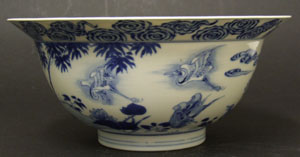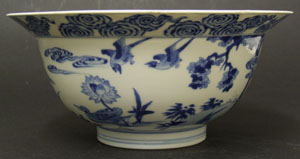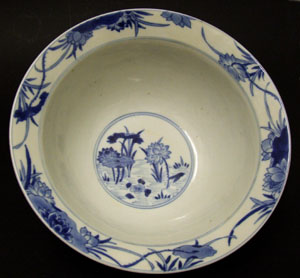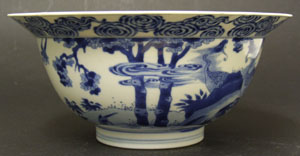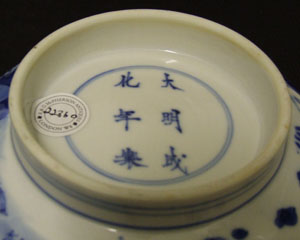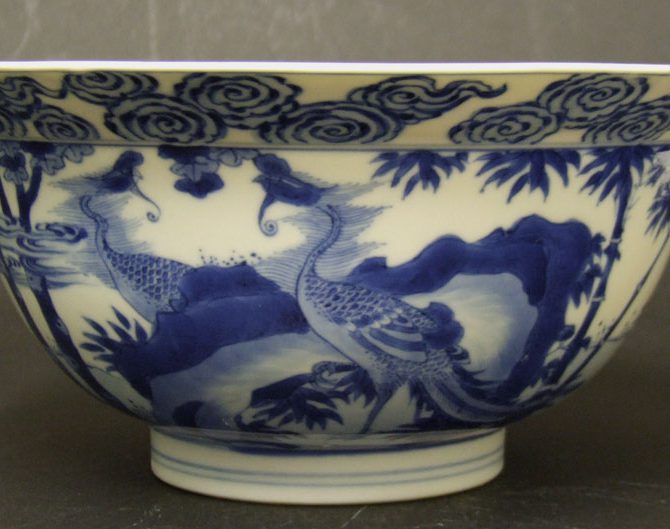
KANGXI 1662 – 1722 Chinese Export Porcelain
A Fine Kangxi Blue and White Porcelain Bowl c.1690-1710. Painted in Rich Clear Tones of Cobalt Blue Against a Pure White Body with a Clear Pearly Glaze. Well Painted with Three Pairs of Birds. A Pair of Phoenix, a Pair of Cranes in Flight, these are Shown with Blue Shading Behind them and Another Pair of Birds. The Interior Painted with Flowering Lotus, the Well Decorated with a Lotus Pond. The Base with an Apocryphal Chenghua Mark (Ming Dynasty 1465-1487).
SOLD
- Condition
- Good, several small shallow chips to the underneath of the rim repaired.
- Size
- Diameter : 21 cm (8 1/4 inches)
- Provenance
- N/A
- Stock number
- 22860
- References
- For two Kangxi blue and white porcelain bowls of of this type see : Chinese Porcelain in the Collection of the Rijksmuseum Amsterdam, The Ming and Qing Dynasties (Christiaan Jorg, Phillip Wilson, The Rijksmuseum, 1997) page 104, plates 96 and 97.
Information
Reign Marks on Kangxi Blue and White Porcelain :
Kangxi blue and white export porcelain object are sometimes found with the six character mark of the emperor Kangxi (1662-1722) to the base. These none-imperial reign marks are referred to as minyao in Chinese, denoting them as `popular wares` not destined for court use. However the majority of the marked pieces bare the mark of earlier Ming dynasty emperors, some are Jiajing (1522-1566), occasionally Wanli (1573-1620) but by far the most commonly encountered marks are those of Chenghua (1465-1487). David Howard in `The Choice of the Private Trader` (David S. Howard, Zwemmer, 1994) notes that "The Chenghua mark .... was not intended as a forgery, but rather as a compliment to the quality of the piece and to replace the mark of Kangxi who had forbidden the use of his name on porcelain made for export after 1682; a ban which nominally remained in force until the late 19th century". It appears this ban was not enforced, or if it was only partly enforced, as we have had many Kangxi export pieces made after this date (1682) that bare the six character Kangxi mark. It is worth noting that many 19th century copies of Kangxi blue and white porcelain bare a four character Kangxi mark, something you do not on the original, all Kangxi marks on porcelain of the period were of six character form.
Phoenix / Fenghuang :
Fenghuang are mythological birds of East Asia that reign over all other birds. The males are called Feng and the females Huang. In modern times, however, such a distinction of gender is often no longer made and the Feng and Huang are blurred into a single feminine entity so that the bird can be paired with the Chinese dragon, which has male connotations. The Fenghuang is also called the `August Cockerel` since it sometimes takes the place of the cockerel in the Chinese Zodiac. In the West, it is commonly referred to as the Chinese phoenix. The Fenghuang has very positive connotations. It is a symbol of high virtue and grace. The Fenghuang also symbolizes the union of yin and yang. In ancient China, they can often be found in the decorations for weddings or royalty, along with dragons. This is because the Chinese considered the dragon and phoenix symbolic of blissful relations between husband and wife, another common yin and yang metaphor. In some traditions it appears in good times but hides during times of trouble, while in other traditions it appeared only to mark the beginning of a new era. In China and Japan it was a symbol of the imperial house, and it represented `fire, the sun, justice, obedience, and fidelity`.
Cranes / He :
One of the most important birds represented in Chinese art is the crane, He. It is a very popular motif representing longevity, it often combined with other longevity symbols such as the pine or shoulou. It`s white feathers further emphasis the connection with long life. Folklore says the crane can live more than six hundred years and has the ability to carry the souls of the dead to the Western Paradise. A pair of cranes represents a wish for a long marriage, a crane can be used in a pun for `together`. A crane flying is symbolic of a wish for a rise in status, among the nine ranks for civil officials the crane represents the first rank.
Lotus :
The lotus is one of the most important symbols in the Chinese art. This Buddhist emblem is a symbol of purity, as the perfect flower grows out of muddy ponds without a stain. The words for lotus in Chinese has the same meaning as to bind, connect (in marriage). It is one of the Eight Auspicious Symbols of Buddhism. It is the flower used to represent summer.
